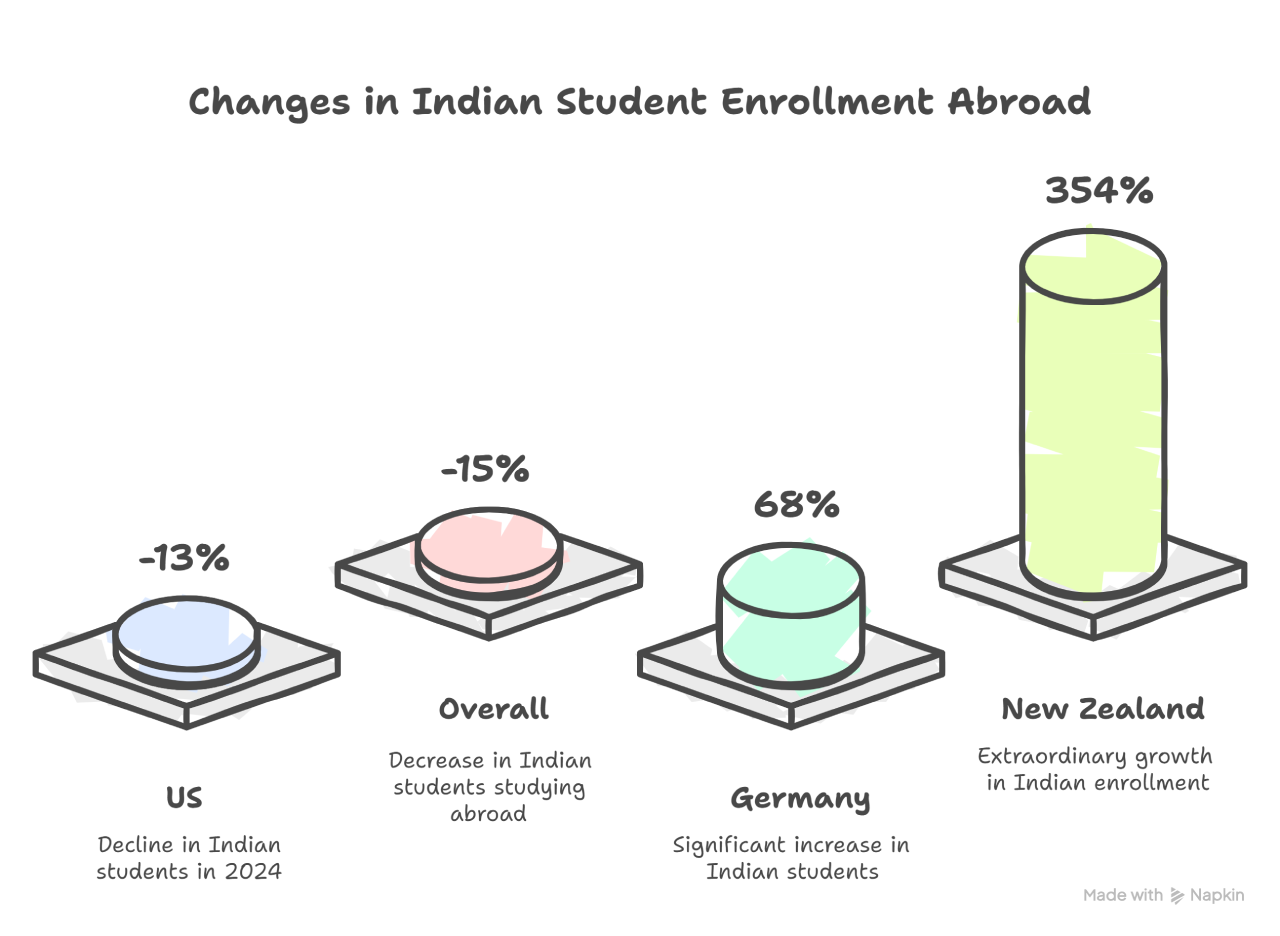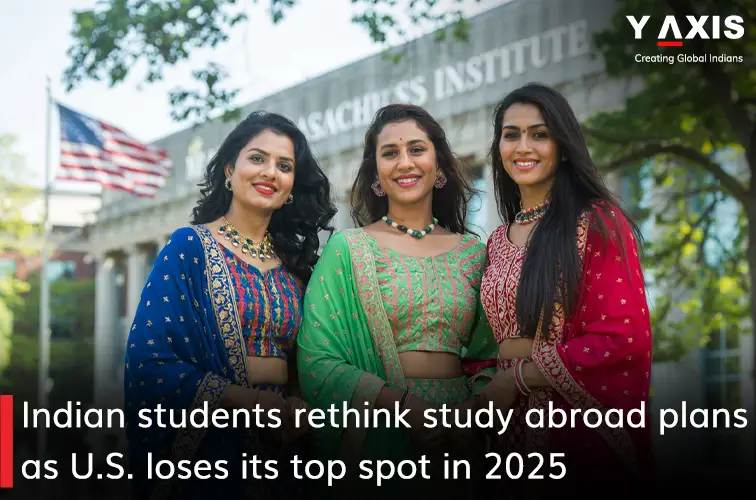Posted on April 22 2025
Indian Students Rethink Study Abroad Plans as US Loses Its Top Spot in 2025
By , Editor
Updated April 22 2025
Your chances of securing a US study visa in 2025 face unprecedented challenges as the landscape of international education undergoes a dramatic shift. The number of Indian students choosing the United States dropped by 13%, falling from 234,500 in 2023 to 204,000 in 2024. In fact, the overall count of Indian students studying abroad decreased from 893,000 to 759,000 during this period, marking a significant 15% decline in degree-seeking students.
However, while traditional Study Abroad destinations like the US, Canada, and the UK experience declining numbers, emerging study destinations tell a different story. Germany witnessed a remarkable 68% increase in Indian student enrollment from 2022 to 2024, while New Zealand reported an extraordinary 354% growth. These shifts reflect changing visa policies, financial requirements, and growing concerns about the depreciation of the Indian rupee against the US dollar, directly affecting your study abroad costs and choices.

Indian Students Shift Focus from US to Emerging Destinations
The global education landscape is witnessing a significant reshuffling as Indian students increasingly abandon traditional study destinations in favor of emerging education hubs. This fundamental shift comes amid growing visa uncertainties, rising costs, and changing immigration policies affecting study abroad decisions.
Germany, France, and New Zealand see record Indian enrolment growth
European countries and New Zealand have emerged as the biggest beneficiaries of Indian students' changing preferences. Germany experienced a remarkable 68% increase in Indian student numbers from 2022 to 2024, growing from 20,700 to 34,700. Additionally, Indians have become the largest international student cohort in Germany, with nearly 50,000 students. The country's appeal stems from high-quality education combined with substantially lower tuition fees compared to traditional destinations.
France has similarly positioned itself as a rising star, setting an ambitious target to host 30,000 Indian students by 2030. The country has already seen a steady increase, with numbers rising from 6,406 in 2022 to 8,536 in 2024—representing a 33% growth over this period. French universities offer nearly 2,000 English-language programs alongside a new French-language foundation program specifically designed for Indian applicants.
Perhaps most striking is New Zealand's meteoric rise in popularity, recording an extraordinary 354% increase in Indian student numbers from 2022 to 2024 (from 1,600 to 7,300). The country has earned enthusiastic endorsements, with nearly nine out of ten international students rating it as a positive study destination. New Zealand's education sector aims to increase its economic contribution to approximately INR 371.27 billion by 2027.
Other emerging destinations gaining traction include:
- Ireland (49% growth from 2022/23 to 2023/24)
- Russia (59% growth from 2022 to 2024)
- The Netherlands, Singapore, and Malaysia
US enrolment drops by 13% as visa and cost concerns rise
Conversely, the United States—long considered the premier destination for Indian students—is experiencing a significant decline. US enrollment dropped by 13% from 2023 to 2024, falling from 234,500 to 204,000. Moreover, active Indian student counts took a sharp dive from 348,446 in July 2024 to 255,447 in August 2024, marking a 28% year-on-year decrease by March 2025.
Several factors are driving this decline. First, visa uncertainties have intensified since Trump returned to office. The American Immigration Lawyers Association (AILA) reported that Indian students make up nearly 50% of visa cancelation cases. A survey examining 327 responses found half of all visa revocation notices were issued to Indians.
Furthermore, financial pressures have become insurmountable for many families. The average tuition fee at top US colleges approaches USD 50,000 annually, with total annual costs (including living expenses of USD 15,000-20,000) easily exceeding USD 65,000. These figures become especially problematic when considering the rupee's depreciation against the dollar, which effectively creates "hidden inflation" for Indian families.
Education loan providers have noticed this shift, with some firms reporting that "enquiries and applications for US loans have halved compared to last year". Lenders are consequently tightening their evaluation processes, prioritizing applicants with strong academic profiles and admissions to top-tier universities.
The potential termination of the Optional Practical Training (OPT) program—which allows international students to work in the US for up to three years after graduation—threatens to further accelerate this decline. As one engineering graduate from Chennai explained when declining a US university offer in favor of Germany: "With tougher work visas, it doesn't just make sense to study there as jobs are not guaranteed".
Visa Policies and Political Climate Reshape Study Abroad Choices
Shifting visa landscapes and political changes are dramatically altering the calculus for Indian students contemplating overseas education. Recent policy developments have created a complex web of challenges for those navigating international study options.
Trump-era immigration policies raise uncertainty for Indian students
The return of Trump administration policies has triggered immediate concerns for Indian students. Several prestigious institutions including Cornell, Columbia, and Yale have unofficially advised international students against leaving the country due to fears about re-entry difficulties. The atmosphere of uncertainty has led to behavioral changes, with many students canceling summer travel plans. The US Department of State has clarified that visas are now considered privileges rather than rights, leading to a zero-tolerance policy toward even minor violations.

OPT and post-study visa changes impact STEM aspirants
A newly proposed bill threatens to eliminate the Optional Practical Training (OPT) program, which currently allows international graduates to work in the US for up to three years after completing their degrees. This potential change would particularly impact STEM students, who benefit from extended work authorization:
- Regular OPT offers 12 months of work authorization for all graduates
- STEM OPT provides an additional 24-month extension (total 36 months)
- Nearly one-third of 300,000 Indian students in the US were eligible for OPT in 2023-24
If passed, this legislation would force many students to either immediately secure an H-1B visa or leave the country. The bill arrives amid concerns from critics who describe OPT as "unauthorized by Congress" and "plagued by diploma mills".
Canada and Australia tighten financial and language requirements
Despite this, alternative destinations are also implementing stricter requirements. Canada has discontinued its Student Direct Stream fast-track visa processing system and now requires language proficiency tests for post-study work visas. Nevertheless, work hour limits have increased from 20 to 24 hours weekly.
Likewise, Australia has introduced tougher financial requirements, with students now needing to show proof of AINR 2,506,943.19. The country has also implemented stricter language proficiency standards and plans to cap international student enrollments at 270,000 for 2025.
Loan Approvals and Currency Fluctuations Add Financial Pressure
Currency fluctuations have emerged as a major obstacle for Indian students considering US education. The financial equation for funding international education has fundamentally changed, creating additional barriers beyond visa concerns.
Rupee depreciation inflates US study costs for Indian families
The Indian rupee's depreciation against the US dollar has created a hidden inflation layer for education costs. Over the past year, the rupee has weakened from ₹82 to ₹87 per dollar, significantly increasing the financial burden on families. This depreciation has affected every aspect of studying abroad:
- A tuition fee of $20,000 that previously cost ₹16.4 lakh now requires ₹17.4 lakh
- Between 2018 and 2025, study abroad costs surged by nearly 24% due to rupee depreciation alone
- A student who initially budgeted ₹32.8 lakh at ₹82 per USD now needs ₹34.8 lakh
This financial pressure extends beyond tuition to accommodation, food, and transportation. For undergraduate programs with total costs exceeding ₹1.5 crore in the US, even minor currency fluctuations create major financial implications. According to experts, this depreciation essentially functions as "hidden inflation" for Indian students.
NBFCs and banks tighten loan approvals for US-bound students
In response to these financial uncertainties, lending institutions have modified their approach toward US-bound students. Currently, 70-80% of Indian students fund their education through loans, with average amounts typically ranging from ₹42-84 lakh.
Financial institutions have increased loan sanction limits, with some now offering up to ₹3 crore. Simultaneously, they've implemented stricter evaluation criteria, prioritizing applicants with strong academic profiles and admissions to top-tier universities. This cautious approach stems from growing concerns about repayment ability, given the uncertain political climate and potential hiring slowdowns.
Previously, many students relied on post-graduation employment to repay loans in dollars. As work opportunities become less certain, lenders report that "enquiries and applications for US loans have halved compared to last year", indicating a significant shift in student confidence regarding financial returns on US education.
Universities and Consultants Adapt to New Student Preferences
Recent trends certainly point toward a significant transformation in global education choices for Indian students. Your study abroad decisions now face complex challenges, from visa uncertainties to currency fluctuations. The US market share dropped 13% between 2023-2024, while alternative destinations like Germany and New Zealand recorded remarkable growth rates of 68% and 354% respectively.
The financial equation has changed drastically. Your education costs now battle against rupee depreciation, which added nearly 24% to overall expenses since 2018. Meanwhile, lending institutions have responded with stricter loan approval criteria, especially for US-bound students.
Political shifts have reshaped the landscape too. Trump-era policies created additional hurdles, particularly through potential changes to the OPT program. As a result, many students like you now evaluate opportunities in countries offering more stable visa policies and affordable education options.
Above all, your study abroad journey requires careful consideration of multiple factors - from visa stability and financial requirements to post-study work opportunities. Therefore, success lies in thorough research and planning, focusing on destinations that align with both your academic goals and practical constraints.
FAQs
Q1. How has the trend of Indian students studying abroad changed recently?
There's been a significant shift in study abroad preferences for Indian students. While traditional destinations like the US have seen a decline, countries like Germany, France, and New Zealand have experienced substantial growth in Indian student enrollments.
Q2. What factors are influencing Indian students' choices for study abroad destinations?
Several factors are influencing choices, including visa policies, political climate, financial considerations, and post-study work opportunities. Currency fluctuations, particularly the depreciation of the Indian rupee against the US dollar, have also played a significant role in decision-making.
Q3. How are visa policies affecting Indian students' study abroad plans?
Visa policies have become a major concern, especially for US-bound students. Stricter policies and uncertainties have led many students to reconsider their options, with some prestigious institutions even advising international students against leaving the country due to re-entry concerns.
Q4. What financial challenges are Indian students facing when planning to study abroad?
Indian students are facing increased financial pressure due to currency depreciation, which has inflated study costs. Additionally, lending institutions have tightened loan approval criteria, especially for US-bound students, making it more challenging to secure education loans.
Q5. How are universities and education consultants responding to these changes?
Universities and consultants are adapting to new student preferences by expanding hybrid programs and alternative pathways. They are also guiding students towards countries with more stable visa policies and affordable education options, helping them navigate the complex landscape of international education.
Tags:
Share
Options for you by Y-Axis
Get it on your mobile
Get News alerts
Contact Y-Axis

